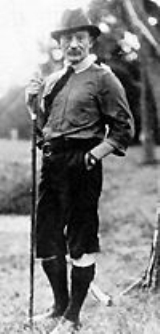
Brownsea Island Scout camp
Encyclopedia
The Brownsea Island Scout camp was a boys camping event on Brownsea Island
in Poole Harbour
, southern England, organised by Lieutenant-General Baden-Powell
to test his ideas for the book Scouting for Boys
. Boys from different social backgrounds participated from 1 August to 8 August 1907 in activities around camping
, observation
, woodcraft
, chivalry
, lifesaving
and patriotism
. Recognised as the world's first Scout camp, the event is regarded as the real origin of the worldwide Scout movement
.
Up to the early 1930s, camping by Boy Scout
s continued on Brownsea Island. In 1963, a formal 50 acres (202,343 m²) Scout campsite was opened by Olave Baden-Powell
, when the island became a nature conservation area owned by the National Trust
. In 1973, a Scout Jamboree
was held on the island with 600 Scouts.
The worldwide centenary of Scouting
took place at the Brownsea Island Scout camp, celebrating 1 August 2007, the 100th anniversary of the start of the first encampment. Activities by The Scout Association
in the campsite include four Scout camps and a Sunrise Ceremony.
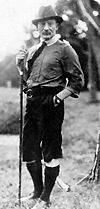 General Baden-Powell
General Baden-Powell
had become a national hero during the Anglo-Boer War
as a result of his successful defence during the Siege of Mafeking
of 1899–1900. During the siege, the Mafeking Cadets
, boys aged 12 to 15 who acted as messengers, had impressed him with their resourcefulness and courage. Baden-Powell had also published a number of popular books on military scouting, including Aids to Scouting for NCOs and men, published in 1899, which became a bestseller and was used by teachers and youth organisations. In the years following the war, he began discussing the idea of a new youth organisation with a number of people, including William Alexander Smith, founder of the Boys' Brigade
, with whom he discussed setting up a Boys Brigade Scouting achievement. To test his ideas while writing Scouting for Boys
, Baden-Powell conceived of an experimental camp, and organised it to take place on Brownsea Island during the summer of 1907. He invited his life-long friend, Major Kenneth McLaren
, to attend the camp as an assistant.
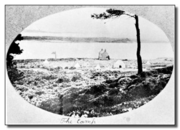 Brownsea Island covers 560 acres (2.3 km²) of woodland and open areas with two lakes. Baden-Powell had visited the site as a boy with his brothers. It perfectly suited his needs for the camp as it was isolated from the mainland and hence the press, but only a short ferry trip from the town of Poole, making the logistics easier. The owner, Charles van Raalte, was happy to offer him use of the site.
Brownsea Island covers 560 acres (2.3 km²) of woodland and open areas with two lakes. Baden-Powell had visited the site as a boy with his brothers. It perfectly suited his needs for the camp as it was isolated from the mainland and hence the press, but only a short ferry trip from the town of Poole, making the logistics easier. The owner, Charles van Raalte, was happy to offer him use of the site.
Baden-Powell invited boys from different social backgrounds to the camp, a revolutionary idea in class-conscious Edwardian England. Eleven came from the well-to-do public schools of Eton
and Harrow
, mostly sons of friends of Baden-Powell. Seven came from the Boys' Brigade
at and three came from the one at Poole
. Baden-Powell's nine year old nephew Donald Baden-Powell also attended. The camp fee was dependent on means: £1 for the public school boys, and three shilling
s and sixpence for the others. The boys were arranged into four patrol
s: Wolves, Ravens, Bulls and Curlews.
The question of how many boys attended the camp has been one that has been disputed. Baden-Powell, in an article in The Scout (1908), Sir Percy Everett
in The First Ten Years (1948) and Rover Word (1936) and E. E. Reynolds in The Scout Movement (1950) all gave a list of 20 boys in 5 patrols with Baden-Powell young nephew, Donald Baden-Powell, as camp orderly. However, William Hillcourt in Two Lives of a Hero (1964) added the fourth Rodney brother, Simon Rodney and later supported this by evidence from the oldest Rodney brother, then the 8th Baron Rodney
. The reasons why Simon Rodney was not listed by the other authors is not clear, but the whole story giving evidence that he was present, as the 6th member of the Curlews Patrol, is given by Colin Walker.
As this was the first Boy Scouting event, the boys did not have uniform shirts, but they did wear khaki scarves
and were presented with brass fleur-de-lis
badges, the first use of the Scout emblem
. They also wore a coloured knot on their shoulder indicating their patrol: green for Bulls, blue for Wolves, yellow for Curlews, and red for Ravens. The patrol leader carried a staff with a flag depicting the patrol animal. After passing tests on knot
s, tracking, and the national flag
, they were given another brass badge, a scroll with the words Be Prepared, to wear below the fleur-de-lis.
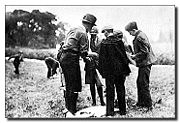
 The camp began with a blast from a kudu
The camp began with a blast from a kudu
horn Baden-Powell had captured in the Matabele campaign
. He used the same kudu horn to open the Coming of Age Jamboree
22 years later in 1929. Baden-Powell made full use of his personal fame as the hero of the Siege of Mafeking
. For many of the participants, the highlights of the camp were his campfire yarns of his African experiences, and the Zulu "Ingonyama" chant, meaning "he is a lion".
Each patrol camped in an army bell tent
. The day began at 6:00 a.m., with cocoa, exercises, flag break and prayers, followed by breakfast at 8:00 a.m. Then followed the morning exercise of the subject of the day, as well as bathing, if deemed necessary. After lunch there was a strict siesta (no talking allowed), followed by the afternoon activity based on the subject of the day. At 5:00 p.m. the day ended with games, supper, campfire yarns and prayers. Turning in for the night was compulsory for every patrol at 9:00 p.m., regardless of age.
Each day was based on a different theme: Day 1 was preliminary, day 2 was campaigning, day 3 was observation, day 4 for woodcraft, day 5 was chivalry, day 6 was saving a life, day 7 was patriotism, and day 8 was the conclusion.
The participants left by ferry on the 9th day, 9 August 1907. Baden-Powell considered the camp successful. The camp ended with a financial deficit of just over £24, with total expenditure of the camp at £55, two shillings, and eight pence. The deficit was cleared by Saxon Noble, whose two sons Marc and Humphrey had attended.
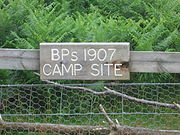
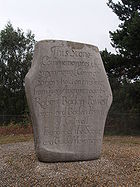 Following the successful camp, Baden-Powell went on an extensive speaking tour arranged by his publisher, Pearsons, to promote the forthcoming Scouting for Boys
Following the successful camp, Baden-Powell went on an extensive speaking tour arranged by his publisher, Pearsons, to promote the forthcoming Scouting for Boys
, which began the Scout movement. It initially appeared as six fortnightly installments, beginning in January 1908, and later appeared in book form. Scouting began to spread throughout Great Britain and Ireland, then through the countries of the British Empire
, and soon to the rest of the world.
A reunion of the original campers was held in 1928 at the Chief Scout's home at Pax Hill
in Hampshire
. A commemorative stone by sculptor Don Potter
was unveiled in 1967. It is located near the encampment area.
In May 2000, twenty trees were planted, one for each boys who attended. During the planting ceremony, the Scout Chief Commissioner
for England, along with representatives of the Scouts and the Guides, planted the trees on the seaward side of the original site. The trees were designed to act as a permanent memorial to the camp, as well as providing a series of future wind breaks against coastal winds.
To give homage to the foundation of scouting many councils have named their NYLT programs "Brownsea".
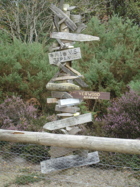 After the death of Charles van Raalte in 1907 his wife Florence stayed on Brownsea until 1925, Mrs. Mary Bonham-Christie bought the island at auction in 1927. In 1932, Bonham-Christie allowed 500 Scouts to camp there to celebrate the Silver Jubilee of Scouting, but shortly afterwards she closed the island to the public and it became very overgrown. In 1934, some Sea Scouts were camping on the island when a fire broke out. Mrs. Bonham-Christie blamed the Sea Scouts, although the fire did not start where the Sea Scouts were camping. The fire engulfed most of the island, burning west to east. The eastern buildings were only saved by a subsequent change in wind direction. No one really knows who started the fire, but Scouts were not allowed to camp on the island again until after her death in 1961. Bonham-Christie left the island a significant tax debt to her grandson, who could not pay the taxes. Fearing the island would be bought by developers, interested citizens raised an endowment and the government allowed the National Trust
After the death of Charles van Raalte in 1907 his wife Florence stayed on Brownsea until 1925, Mrs. Mary Bonham-Christie bought the island at auction in 1927. In 1932, Bonham-Christie allowed 500 Scouts to camp there to celebrate the Silver Jubilee of Scouting, but shortly afterwards she closed the island to the public and it became very overgrown. In 1934, some Sea Scouts were camping on the island when a fire broke out. Mrs. Bonham-Christie blamed the Sea Scouts, although the fire did not start where the Sea Scouts were camping. The fire engulfed most of the island, burning west to east. The eastern buildings were only saved by a subsequent change in wind direction. No one really knows who started the fire, but Scouts were not allowed to camp on the island again until after her death in 1961. Bonham-Christie left the island a significant tax debt to her grandson, who could not pay the taxes. Fearing the island would be bought by developers, interested citizens raised an endowment and the government allowed the National Trust
to take control of the island using this endowment in 1962.
The island was reopened to the public in 1963 by Lady Baden-Powell
when it came under the control of the National Trust, which has since then continuously maintained the island as a conservation area which is popular site with visitors: including Scouts, Guides, and the general public. Soon after the National Trust took over the island in 1964, 50 acres (202,343 m²) near this original campsite were set aside for Scout and Guide camping. In 1973, a Jamboree
was held on the island for 600 Scouts from seven nations, along with one of the original campers, aged 81.
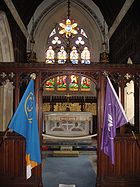 The campsite is compartmentalised, with the memorial stone, shop, flags, destination signs, all in one area on the south-west corner of the island. Radiating off from this are many small camp zones, perhaps a dozen acres each, surrounded by trees and fences. The area set aside for camping now covers 50 acres (202,343 m²) and there is room for between 300 and 400 campers on the site. The Scout campsite and parts of the island have been cleared, and Scouts have been able to camp there since 1964.
The campsite is compartmentalised, with the memorial stone, shop, flags, destination signs, all in one area on the south-west corner of the island. Radiating off from this are many small camp zones, perhaps a dozen acres each, surrounded by trees and fences. The area set aside for camping now covers 50 acres (202,343 m²) and there is room for between 300 and 400 campers on the site. The Scout campsite and parts of the island have been cleared, and Scouts have been able to camp there since 1964.
The National Trust maintains the Scout and Guide campsite, South Shore Lodge and the Baden-Powell Outdoor Centre where members of Brownsea Island Scout Fellowship and Friends of Guiding, Brownsea Island operate a small trading post. The Baden-Powell Outdoor Centre was opened on 14 September 2007. It contains a new camp reception, new washrooms and toilet facilities. The centre also hosts a small Scouting museum.
The altar of St. Mary's Church (about 0.2 mile (0.321868 km) from the camp) is lined with a Scout and a Guide flag. In 2007, to coincide with the Scouting centenary, about 40 new kneelers or hassocks were given to the church, decorated with the 21 World Scout Jamboree badges and other Scouting, Guiding and island badges . It is often used for services during large camps. Baden-Powell and his wife are buried in Kenya, there is no memorial to them in the Church.
Brownsea Island is generally open to the public from March to October, via ferry from Poole. By exception, the island was reserved for Scouts and Scouters on 1 August 2007 during the Sunrise Camp. The National Trust is operating a number of events throughout the summer months including guided tours, trails and activities in the visitor centre.
Scouts and Guides often do an "act of duty" whilst on the island; often this involves cutting back the rhodedendron added by a previous owner of the island, maintaining the Baden-Powell Outdoor centre by stacking rhodedendron in the wood-piles or raking the dead leaves, twigs and pine-needles from underneath pine trees so more plants that red squirrels eat can grow.
during July/August.
Brownsea Island
Brownsea Island is the largest of the islands in Poole Harbour in the county of Dorset, England. The island is owned by the National Trust. Much of the island is open to the public and includes areas of woodland and heath with a wide variety of wildlife, together with cliff top views across Poole...
in Poole Harbour
Poole Harbour
Poole Harbour is a large natural harbour in Dorset, southern England, with the town of Poole on its shores. The harbour is a drowned valley formed at the end of the last ice age and is the estuary of several rivers, the largest being the Frome. The harbour has a long history of human settlement...
, southern England, organised by Lieutenant-General Baden-Powell
Robert Baden-Powell, 1st Baron Baden-Powell
Robert Stephenson Smyth Baden-Powell, 1st Baron Baden-Powell, Bt, OM, GCMG, GCVO, KCB , also known as B-P or Lord Baden-Powell, was a lieutenant-general in the British Army, writer, and founder of the Scout Movement....
to test his ideas for the book Scouting for Boys
Scouting for Boys
Scouting for Boys: A Handbook for Instruction in Good Citizenship is the first book on the Scout Movement, published in 1908. It was written and illustrated by Robert Baden-Powell, its founder...
. Boys from different social backgrounds participated from 1 August to 8 August 1907 in activities around camping
Camping
Camping is an outdoor recreational activity. The participants leave urban areas, their home region, or civilization and enjoy nature while spending one or several nights outdoors, usually at a campsite. Camping may involve the use of a tent, caravan, motorhome, cabin, a primitive structure, or no...
, observation
Observation
Observation is either an activity of a living being, such as a human, consisting of receiving knowledge of the outside world through the senses, or the recording of data using scientific instruments. The term may also refer to any data collected during this activity...
, woodcraft
Woodcraft
Woodcraft is a recreational/educational program devised by Ernest Thompson Seton in 1902, for young people based on camping, outdoor skills and woodcrafts. Thompson Seton's Woodcraft ideas were incorporated into the early Scout movement, but also in many other organisations in many countries.In the...
, chivalry
Chivalry
Chivalry is a term related to the medieval institution of knighthood which has an aristocratic military origin of individual training and service to others. Chivalry was also the term used to refer to a group of mounted men-at-arms as well as to martial valour...
, lifesaving
Lifesaving
Lifesaving is the act involving rescue, resuscitation and first aid. It often refers to water safety and aquatic rescue however it could include ice rescue, flood and river rescue, swimming pool rescue and other emergency medical services. Lifesaving also refers to sport where lifesavers compete...
and patriotism
Patriotism
Patriotism is a devotion to one's country, excluding differences caused by the dependencies of the term's meaning upon context, geography and philosophy...
. Recognised as the world's first Scout camp, the event is regarded as the real origin of the worldwide Scout movement
Scouting
Scouting, also known as the Scout Movement, is a worldwide youth movement with the stated aim of supporting young people in their physical, mental and spiritual development, that they may play constructive roles in society....
.
Up to the early 1930s, camping by Boy Scout
Boy Scout
A Scout is a boy or a girl, usually 11 to 18 years of age, participating in the worldwide Scouting movement. Because of the large age and development span, many Scouting associations have split this age group into a junior and a senior section...
s continued on Brownsea Island. In 1963, a formal 50 acres (202,343 m²) Scout campsite was opened by Olave Baden-Powell
Olave Baden-Powell
Olave St Clair Baden-Powell, Baroness Baden-Powell, GBE was born Olave St Clair Soames in Chesterfield, England...
, when the island became a nature conservation area owned by the National Trust
National Trust for Places of Historic Interest or Natural Beauty
The National Trust for Places of Historic Interest or Natural Beauty, usually known as the National Trust, is a conservation organisation in England, Wales and Northern Ireland...
. In 1973, a Scout Jamboree
Jamboree (Scouting)
In Scouting, a jamboree is a large gathering of Scouts who rally at a national or international level.The 1st World Scout Jamboree was held in 1920, and was hosted by the United Kingdom...
was held on the island with 600 Scouts.
The worldwide centenary of Scouting
Scouting 2007 Centenary
The Scouting 2007 Centenary comprised celebrations around the world in which Scouts celebrated 100 years of the world Scout movement. The original celebrations were focused on the United Kingdom, such as the camp on Brownsea Island, the birthplace of Scouting, and the 21st World Scout Jamboree in...
took place at the Brownsea Island Scout camp, celebrating 1 August 2007, the 100th anniversary of the start of the first encampment. Activities by The Scout Association
The Scout Association
The Scout Association is the World Organization of the Scout Movement recognised Scouting association in the United Kingdom. Scouting began in 1907 through the efforts of Robert Baden-Powell. The Scout Association was formed under its previous name, The Boy Scout Association, in 1910 by the grant...
in the campsite include four Scout camps and a Sunrise Ceremony.
Background

Robert Baden-Powell, 1st Baron Baden-Powell
Robert Stephenson Smyth Baden-Powell, 1st Baron Baden-Powell, Bt, OM, GCMG, GCVO, KCB , also known as B-P or Lord Baden-Powell, was a lieutenant-general in the British Army, writer, and founder of the Scout Movement....
had become a national hero during the Anglo-Boer War
Second Boer War
The Second Boer War was fought from 11 October 1899 until 31 May 1902 between the British Empire and the Afrikaans-speaking Dutch settlers of two independent Boer republics, the South African Republic and the Orange Free State...
as a result of his successful defence during the Siege of Mafeking
Siege of Mafeking
The Siege of Mafeking was the most famous British action in the Second Boer War. It took place at the town of Mafeking in South Africa over a period of 217 days, from October 1899 to May 1900, and turned Robert Baden-Powell, who went on to found the Scouting Movement, into a national hero...
of 1899–1900. During the siege, the Mafeking Cadets
Mafeking Cadet Corps
The Mafeking Cadet Corps was a group of boy cadets during the Siege of Mafeking in South Africa. They are sometimes seen as forerunners of the Scouts, because they were one of Robert Baden-Powell's inspirations in creating of the Scout movement in 1907....
, boys aged 12 to 15 who acted as messengers, had impressed him with their resourcefulness and courage. Baden-Powell had also published a number of popular books on military scouting, including Aids to Scouting for NCOs and men, published in 1899, which became a bestseller and was used by teachers and youth organisations. In the years following the war, he began discussing the idea of a new youth organisation with a number of people, including William Alexander Smith, founder of the Boys' Brigade
Boys' Brigade
For the 80s New Wave band from Canada, see Boys Brigade .The Boys' Brigade is an interdenominational Christian youth organisation, conceived by William Alexander Smith to combine drill and fun activities with Christian values...
, with whom he discussed setting up a Boys Brigade Scouting achievement. To test his ideas while writing Scouting for Boys
Scouting for Boys
Scouting for Boys: A Handbook for Instruction in Good Citizenship is the first book on the Scout Movement, published in 1908. It was written and illustrated by Robert Baden-Powell, its founder...
, Baden-Powell conceived of an experimental camp, and organised it to take place on Brownsea Island during the summer of 1907. He invited his life-long friend, Major Kenneth McLaren
Kenneth McLaren
Kenneth McLaren , DSO, was a Major in the 13th Hussars regiment of the British Army. After his military service he assisted with the growth of the Scouting movement founded by his friend Robert Baden-Powell....
, to attend the camp as an assistant.
Site and camp organisation

Baden-Powell invited boys from different social backgrounds to the camp, a revolutionary idea in class-conscious Edwardian England. Eleven came from the well-to-do public schools of Eton
Eton College
Eton College, often referred to simply as Eton, is a British independent school for boys aged 13 to 18. It was founded in 1440 by King Henry VI as "The King's College of Our Lady of Eton besides Wyndsor"....
and Harrow
Harrow School
Harrow School, commonly known simply as "Harrow", is an English independent school for boys situated in the town of Harrow, in north-west London.. The school is of worldwide renown. There is some evidence that there has been a school on the site since 1243 but the Harrow School we know today was...
, mostly sons of friends of Baden-Powell. Seven came from the Boys' Brigade
Boys' Brigade
For the 80s New Wave band from Canada, see Boys Brigade .The Boys' Brigade is an interdenominational Christian youth organisation, conceived by William Alexander Smith to combine drill and fun activities with Christian values...
at and three came from the one at Poole
Poole
Poole is a large coastal town and seaport in the county of Dorset, on the south coast of England. The town is east of Dorchester, and Bournemouth adjoins Poole to the east. The Borough of Poole was made a unitary authority in 1997, gaining administrative independence from Dorset County Council...
. Baden-Powell's nine year old nephew Donald Baden-Powell also attended. The camp fee was dependent on means: £1 for the public school boys, and three shilling
Shilling
The shilling is a unit of currency used in some current and former British Commonwealth countries. The word shilling comes from scilling, an accounting term that dates back to Anglo-Saxon times where it was deemed to be the value of a cow in Kent or a sheep elsewhere. The word is thought to derive...
s and sixpence for the others. The boys were arranged into four patrol
Patrol
A patrol is commonly a group of personnel, such as police officers or soldiers, that are assigned to monitor a specific geographic area.- Military :...
s: Wolves, Ravens, Bulls and Curlews.
The question of how many boys attended the camp has been one that has been disputed. Baden-Powell, in an article in The Scout (1908), Sir Percy Everett
Percy Everett
Sir Percy Winn Everett was an editor-in-chief for the house of Pearson and an active Scouter who became the Deputy Chief Scout of Great Britain....
in The First Ten Years (1948) and Rover Word (1936) and E. E. Reynolds in The Scout Movement (1950) all gave a list of 20 boys in 5 patrols with Baden-Powell young nephew, Donald Baden-Powell, as camp orderly. However, William Hillcourt in Two Lives of a Hero (1964) added the fourth Rodney brother, Simon Rodney and later supported this by evidence from the oldest Rodney brother, then the 8th Baron Rodney
Baron Rodney
Baron Rodney, of Rodney Stoke in the County of Somerset, is a title in the Peerage of Great Britain. It was created in 1782 for the naval commander Sir George Brydges Rodney, 1st Baronet. He had previously been created a Baronet, of Alresford in the County of Southampton, in the Baronetage of Great...
. The reasons why Simon Rodney was not listed by the other authors is not clear, but the whole story giving evidence that he was present, as the 6th member of the Curlews Patrol, is given by Colin Walker.
As this was the first Boy Scouting event, the boys did not have uniform shirts, but they did wear khaki scarves
Neckerchief
A neckerchief, necker or less commonly scarf is a type of neckwear associated with Scouts, cowboys and sailors. It consists of a triangular piece of cloth or a rectangular piece folded into a triangle. The long edge is rolled towards the point, leaving a portion unrolled...
and were presented with brass fleur-de-lis
Fleur-de-lis
The fleur-de-lis or fleur-de-lys is a stylized lily or iris that is used as a decorative design or symbol. It may be "at one and the same time, political, dynastic, artistic, emblematic, and symbolic", especially in heraldry...
badges, the first use of the Scout emblem
World Crest
The World Scout Emblem is the emblem of the World Organization of the Scout Movement and is worn by Scouts and Scouters around the world to indicate their membership...
. They also wore a coloured knot on their shoulder indicating their patrol: green for Bulls, blue for Wolves, yellow for Curlews, and red for Ravens. The patrol leader carried a staff with a flag depicting the patrol animal. After passing tests on knot
Knot
A knot is a method of fastening or securing linear material such as rope by tying or interweaving. It may consist of a length of one or several segments of rope, string, webbing, twine, strap, or even chain interwoven such that the line can bind to itself or to some other object—the "load"...
s, tracking, and the national flag
Union Flag
The Union Flag, also known as the Union Jack, is the flag of the United Kingdom. It retains an official or semi-official status in some Commonwealth Realms; for example, it is known as the Royal Union Flag in Canada. It is also used as an official flag in some of the smaller British overseas...
, they were given another brass badge, a scroll with the words Be Prepared, to wear below the fleur-de-lis.
Programme


Greater Kudu
The Greater Kudu is a woodland antelope found throughout eastern and southern Africa. Despite occupying such widespread territory, they are sparsely populated in most areas, due to a declining habitat, deforestation and hunting....
horn Baden-Powell had captured in the Matabele campaign
Second Matabele War
The Second Matabele War, also known as the Matabeleland Rebellion and in Zimbabwe as the First Chimurenga, was fought in 1896–97 between the British troops and the Ndebele people....
. He used the same kudu horn to open the Coming of Age Jamboree
3rd World Scout Jamboree
The 3rd World Scout Jamboree was held in 1929 at Arrowe Park in Upton, Merseyside, United Kingdom. As it was commemorating the 21st birthday of Scouting for Boys and the Scouting movement, it is also known as the Coming of Age Jamboree...
22 years later in 1929. Baden-Powell made full use of his personal fame as the hero of the Siege of Mafeking
Siege of Mafeking
The Siege of Mafeking was the most famous British action in the Second Boer War. It took place at the town of Mafeking in South Africa over a period of 217 days, from October 1899 to May 1900, and turned Robert Baden-Powell, who went on to found the Scouting Movement, into a national hero...
. For many of the participants, the highlights of the camp were his campfire yarns of his African experiences, and the Zulu "Ingonyama" chant, meaning "he is a lion".
Each patrol camped in an army bell tent
Bell tent
A bell tent is a human shelter for inhabiting, traveling or leisure. The design is a simple structure, supported by a single central pole, covered with a cotton canvas. The stability of the tent is reinforced with tension by guy ropes connected around the top of the walls and being held down by...
. The day began at 6:00 a.m., with cocoa, exercises, flag break and prayers, followed by breakfast at 8:00 a.m. Then followed the morning exercise of the subject of the day, as well as bathing, if deemed necessary. After lunch there was a strict siesta (no talking allowed), followed by the afternoon activity based on the subject of the day. At 5:00 p.m. the day ended with games, supper, campfire yarns and prayers. Turning in for the night was compulsory for every patrol at 9:00 p.m., regardless of age.
Each day was based on a different theme: Day 1 was preliminary, day 2 was campaigning, day 3 was observation, day 4 for woodcraft, day 5 was chivalry, day 6 was saving a life, day 7 was patriotism, and day 8 was the conclusion.
The participants left by ferry on the 9th day, 9 August 1907. Baden-Powell considered the camp successful. The camp ended with a financial deficit of just over £24, with total expenditure of the camp at £55, two shillings, and eight pence. The deficit was cleared by Saxon Noble, whose two sons Marc and Humphrey had attended.
Legacy and commemoration


Scouting for Boys
Scouting for Boys: A Handbook for Instruction in Good Citizenship is the first book on the Scout Movement, published in 1908. It was written and illustrated by Robert Baden-Powell, its founder...
, which began the Scout movement. It initially appeared as six fortnightly installments, beginning in January 1908, and later appeared in book form. Scouting began to spread throughout Great Britain and Ireland, then through the countries of the British Empire
British Empire
The British Empire comprised the dominions, colonies, protectorates, mandates and other territories ruled or administered by the United Kingdom. It originated with the overseas colonies and trading posts established by England in the late 16th and early 17th centuries. At its height, it was the...
, and soon to the rest of the world.
A reunion of the original campers was held in 1928 at the Chief Scout's home at Pax Hill
Pax Hill
Pax Hill, near Bentley, Hampshire, England, was the family home of Robert Baden-Powell, founder of the Scout movement, and his wife, Olave, for over twenty years during the 20th century. It is located at the end of a half-mile drive, off the main A31 road....
in Hampshire
Hampshire
Hampshire is a county on the southern coast of England in the United Kingdom. The county town of Hampshire is Winchester, a historic cathedral city that was once the capital of England. Hampshire is notable for housing the original birthplaces of the Royal Navy, British Army, and Royal Air Force...
. A commemorative stone by sculptor Don Potter
Don Potter
Donald Steele Potter , was an English sculptor, wood carver, potter and teacher.-Early life:Don Potter was born in Newington, near Sittingbourne, Kent, the son of a school teacher, and attended a private school...
was unveiled in 1967. It is located near the encampment area.
In May 2000, twenty trees were planted, one for each boys who attended. During the planting ceremony, the Scout Chief Commissioner
Chief Commissioner
A Chief Commissioner is a commissioner of a high rank, usually in chief of several Commissioners or similarly styled officers.-Colonial:In British India the gubernatorial style was Chief Commissioner in various provinces , the style being applied especially where an elected assembly did not exist,...
for England, along with representatives of the Scouts and the Guides, planted the trees on the seaward side of the original site. The trees were designed to act as a permanent memorial to the camp, as well as providing a series of future wind breaks against coastal winds.
To give homage to the foundation of scouting many councils have named their NYLT programs "Brownsea".
From 1927 to 2000

National Trust for Places of Historic Interest or Natural Beauty
The National Trust for Places of Historic Interest or Natural Beauty, usually known as the National Trust, is a conservation organisation in England, Wales and Northern Ireland...
to take control of the island using this endowment in 1962.
The island was reopened to the public in 1963 by Lady Baden-Powell
Olave Baden-Powell
Olave St Clair Baden-Powell, Baroness Baden-Powell, GBE was born Olave St Clair Soames in Chesterfield, England...
when it came under the control of the National Trust, which has since then continuously maintained the island as a conservation area which is popular site with visitors: including Scouts, Guides, and the general public. Soon after the National Trust took over the island in 1964, 50 acres (202,343 m²) near this original campsite were set aside for Scout and Guide camping. In 1973, a Jamboree
Jamboree (Scouting)
In Scouting, a jamboree is a large gathering of Scouts who rally at a national or international level.The 1st World Scout Jamboree was held in 1920, and was hosted by the United Kingdom...
was held on the island for 600 Scouts from seven nations, along with one of the original campers, aged 81.
After 2000

The National Trust maintains the Scout and Guide campsite, South Shore Lodge and the Baden-Powell Outdoor Centre where members of Brownsea Island Scout Fellowship and Friends of Guiding, Brownsea Island operate a small trading post. The Baden-Powell Outdoor Centre was opened on 14 September 2007. It contains a new camp reception, new washrooms and toilet facilities. The centre also hosts a small Scouting museum.
The altar of St. Mary's Church (about 0.2 mile (0.321868 km) from the camp) is lined with a Scout and a Guide flag. In 2007, to coincide with the Scouting centenary, about 40 new kneelers or hassocks were given to the church, decorated with the 21 World Scout Jamboree badges and other Scouting, Guiding and island badges . It is often used for services during large camps. Baden-Powell and his wife are buried in Kenya, there is no memorial to them in the Church.
Brownsea Island is generally open to the public from March to October, via ferry from Poole. By exception, the island was reserved for Scouts and Scouters on 1 August 2007 during the Sunrise Camp. The National Trust is operating a number of events throughout the summer months including guided tours, trails and activities in the visitor centre.
Scouts and Guides often do an "act of duty" whilst on the island; often this involves cutting back the rhodedendron added by a previous owner of the island, maintaining the Baden-Powell Outdoor centre by stacking rhodedendron in the wood-piles or raking the dead leaves, twigs and pine-needles from underneath pine trees so more plants that red squirrels eat can grow.
Centenary of Scouting
Since March 2006, travel packages have been available for Scouts to camp on the island, while Scout and Guide groups can also book day activities. To celebrate one hundred years of Scouting, four camps are organised on the island by The Scout AssociationThe Scout Association
The Scout Association is the World Organization of the Scout Movement recognised Scouting association in the United Kingdom. Scouting began in 1907 through the efforts of Robert Baden-Powell. The Scout Association was formed under its previous name, The Boy Scout Association, in 1910 by the grant...
during July/August.
- The Patrol Leaders Camp, ran from 26 until 28 July 2007, was the first of the four camps and involved Scouts from the United Kingdom in activities such as sea kayaking.
- The Replica Camp was a living historyLiving historyLiving history is an activity that incorporates historical tools, activities and dress into an interactive presentation that seeks to give observers and participants a sense of stepping back in time. Although it does not necessarily seek to reenact a specific event in history, living history is...
and recreation for visitors of the original 1907 camp on Brownsea Island, which ran from 28 July to 3 August 2007, parallel to the other camps. - The Sunrise Camp (29 July to 1 August 2007) hosted over 300 Scouts from nearly every country in the world. The young people traveled from the World Scout JamboreeWorld Scout JamboreeThe World Scout Jamboree is a Scouting jamboree of the World Organization of the Scout Movement, typically attended by several tens of thousands of Scouts from around the world, aged 14 to 17....
in Hylands ParkHylands ParkHylands House is a Grade II* neo-classical villa situated within Hylands Park a 232-hectare park south-west of Chelmsford in Essex in South East England. It is owned and operated by Chelmsford Borough Council.-History:...
, Essex to Brownsea Island to be at this landmark of Scouting on 1 August 2007 for the Sunrise Ceremony. At 8am, Scouts all over the world renewed their Scout promiseScout PromiseSince the publication of Scouting for Boys in 1908, all Scouts and Guides around the world have taken a Scout promise or oath to live up to ideals of the movement, and subscribed to a Scout Law. The wording of the Scout Promise and Scout Law have varied slightly over time and from country to...
, the focus was to make the world a better and more peaceful place. - Finally, the New Centenary Camp (1 until 4 August 2007) hosted Scouts from both the United Kingdom and abroad, celebrating the start of the second century for Scouting. Scouts from all backgrounds and religions came together to show the world that peace is possible in the same way that Baden-Powell brought together boys from different classes for the first camp back in 1907.

